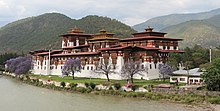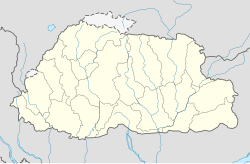
Back পুনাখা ডিজং Bengali/Bangla Punakha Dzong Catalan Punakha-Dzong German Dzong Punakha Spanish Punakha Dzong Hungarian Punakha Dzong ID Dzong di Punakha Italian Punakha Dzong Malay Punakha Dzong Burmese Punakha Dzong Portuguese
| Punakha Dzong Pungthang Dechen Phodrang Dzong | |
|---|---|
 Pungthang Dechen Phodrang Dzong at Punakha and Jacaranda trees | |
| Religion | |
| Affiliation | Tibetan Buddhism |
| Location | |
| Location | Punakha, Bhutan |
| Geographic coordinates | 27°34′55″N 89°51′47″E / 27.58194°N 89.86306°E |
The Punakha Dzong, also known as Pungthang Dewa chhenbi Phodrang (meaning "the palace of great happiness or bliss"[1][2]), is the administrative centre of Punakha District in Punakha, Bhutan. Constructed by Ngawang Namgyal, 1st Zhabdrung Rinpoche, in 1637–38,[1][3] it is the second oldest and second-largest dzong in Bhutan and one of its most majestic structures.[1][4] The dzong houses the sacred relics of the southern Drukpa Lineage of the Kagyu school of Tibetan Buddhism, including the Rangjung Kharsapani and the sacred remains of Ngawang Namgyal and the tertön Pema Lingpa.
Punakha Dzong was the administrative center and the seat of the Government of Bhutan until 1955 when the capital was moved to Thimphu.[2][4][5] It is listed as a tentative site in Bhutan's Tentative List for UNESCO inclusion.
- ^ a b c "Dzong at Punakha". Archived from the original on 2010-03-26. Retrieved 2010-04-01.
The second oldest dzong in Bhutan, it was begun in 1637 also on the order of Shabdrung Ngawang Namgyal. The dzong was significantly expanded from 1744 to 1763 during the reign of the 13th desi (the secular ruler, as opposed to the Je Khenpo, who is the chief abbot of Bhutan, and who holds equal power), Sherab Wangchuk.
- ^ a b Wangchuck, Ashi Dorji Wangmo (2006). Treasures of the thunder dragon: a portrait of Bhutan. Penguin, Viking. pp. 40–41, 102. ISBN 0-670-99901-6. Archived from the original on 2022-10-13. Retrieved 2010-04-01.
- ^ Pommaret, Francoise (2006). Bhutan Himalayan Mountains Kingdom (5th ed.). Odyssey Books and Guides. p. 192.
- ^ a b "Punakha Dzong". Tourism:Government of Bhutan. Archived from the original on 2017-09-07. Retrieved 2010-04-01.
- ^ Brown, Lindsay; Bradley Mayhew; Stan Armington; Richard Whitecros (2007). Bhutan. Lonely Planet. pp. 146–147. ISBN 978-1-74059-529-2. Archived from the original on 2022-10-13. Retrieved 2010-04-01.
© MMXXIII Rich X Search. We shall prevail. All rights reserved. Rich X Search
